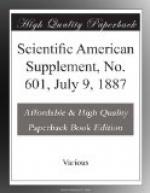Last year in the latter case the double bottom was filled with coal; and after the charge, which was lashed against the ship in the same way, had been exploded, it was found that the bilge keel had been shivered for a length of 20 ft., while the lower plating had been much bulged above the bilge keel. Four strakes of the skin plating extending up to the armor shelf had also been forced inward and fractured where they crossed the longitudinal frames. They had parted in the middle for a distance of 8 ft., while some of the butts had been opened so that gashes 2 in. or 3 in. wide appeared between them. The coal had been pulverized and scattered in all directions, and other internal damage inflicted. Nevertheless, the watertight bulkheads remained intact, and by confining the influx of water to a single compartment so much buoyancy was preserved that, though the ship heeled over to starboard and was maimed, she remained afloat, and might have continued to fight her guns, provided always that no injury had been sustained by her machinery, a point which these experiments do not touch. Crippled, however, as she was, it was thought at the time (and the probability was strengthened by subsequent examination of the ship in dock) that the coal, instead of being a protection to the double bottom, had in reality proved a source of weakness by receiving the energy of the explosion from the outer plating and communicating it to the inner plating, and so distributing it throughout the submerged portions of the hulk.
The question was sufficiently important to demand an experimental solution; hence the raison d’etre of the present demonstration. The double bottom, which is about 21/2 ft. deep, was consequently kept empty, and the torpedo placed in immediate contact with it in such a manner that, being overhung by the contour of the hull, the ship would feel the full force of the upward as well as the lateral energy of the charge. On other accounts the importance of the experiment was obvious, for, although it had been ascertained that torpedo nets were capable of protecting a battle ship from the bursts of the heaviest locomotive and outrigger charges, it might happen, of course, that the nets would be rent or displaced by shell fire or swept away by a grazing ram or even attacked by a double torpedo, the second passing through the gashes made by the explosion of the first in any case. It was, therefore, of urgent necessity that the effect of a torpedo bursting in immediate contact with a ship’s bottom should be practically and clearly determined. The charge on June 13 was fired just before 5 p.m. in the wake of the boilers, and it was soon perceived that something of a fatal character had taken place from the appearance of coal dust sweeping up through the hold. The report had not the dull boom to which the spectators had become accustomed. Instead of this, the gun cotton exploded with a sharp, angry, whistling noise, while the manner in which the mud was churned up showed that the force of the rebound was terrific. The ship lifted bodily near the stern, after which it was seen to leisurely heel over to starboard some eight or ten degrees, and finally repose, though not until the tide fell, upon the mud. The old hulk had been mortally wounded at last.




